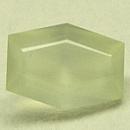|
ClassicGems.net |
|
|
 |
| Williamsite (variety of Antigorite) |
|
|
Discovered in 1848; IMA status: Not Valid (variety name) | |||
|
|
|
Chemistry |
|
|
| |
|
(Mg,Fe2+)3Si2O5(OH)4 + Cr | |
|
|
Magnesium Iron Silicate Hydroxide + Chromium |
|
|
|
|
More Information |
|
|
|
|
|
|
Williamsite
is a variety of Antigorite. |
|
Synonyms: |
Chrome Antigorite |
|
Type Locality: |
State Line Chrome Mine which lies just inside Lancaster County, Pennsylvania |
|
Year Discovered: |
1848 |
|
View mineral photos: | |
|
|
|
|
More Information |
|
|
|
|
|
|
Mindat.org
(Williamsite)
|
|
|
|
|
Williamsite is a translucent, pale, apple green to intense, chrome green variety of Antigorite that gets its color from the presence of chromium (Cr) in its chemistry. It often contains inclusions of dark, octahedral microcrystals of Chromite. Williamsite from some localities has a jade-green color and has been used as a Jade simulant. Williamsite has a Mohs hardness of 3.5 - 4.0 and a vitreous to resinous luster. Antigorite is a member of the Serpentine Group of minerals that also includes Chrysotile and Lizardite. Williamsite was named in 1848 by American mineralogist Charles Upham Shepard (1804-1886) in honor of its discoverer, Lewis White Williams (1804-1873), a mineralogist and geologist of West Chester, Chester County, Pennsylvania. Williamsite originally came from the historic State Line Chrome Mine which lies just inside Lancaster County, Pennsylvania on the Pennsylvania-Maryland border. This mine was active from the 1800's into the early 1900's. Williamsite has also been found at Wood's Chrome Mine, Texas, Little Britain Township, Lancaster County, Pennsylvania, USA. However, as of Summer 2012, the property and mine are closed to collectors. |
|
|
Williamsite gems for sale: We have not photographed our Williamsite gems yet. Please check back soon. |